For Spring/Summer 19, Patagonia is releasing a line of Made in USA wading boots, produced in collaboration with Danner. This model caught my eye.
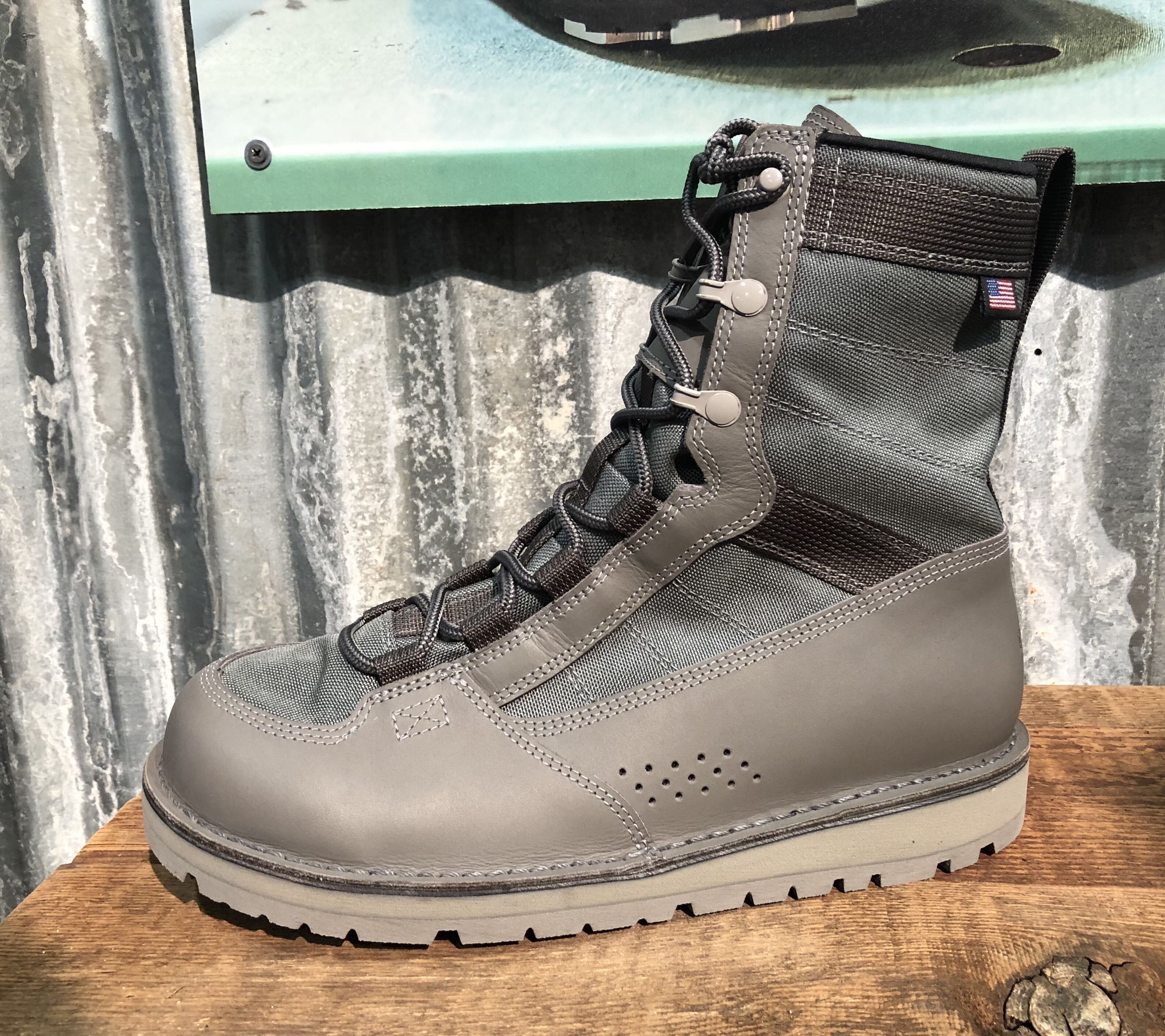
For Spring/Summer 19, Patagonia is releasing a line of Made in USA wading boots, produced in collaboration with Danner. This model caught my eye.

In this final installment of our series on The Lost Arrow Project’s Military Alpine Recce System, I wanted to take a deep dive on two garments. While the entire system was a ground up reboot of environmental clothing systems and packed with innovative concepts, these two jacket and pant combinations exhibit the systems’ departure from the status quo.
Earlier I referred to MARS as a take out menu and I believe that the Pnuemo Fuse and Mixed Range will be the most popular pieces in MARS, serving as the definition of what Patagonia designer Casey Shaw aspired to when he pondered how to make one garment replace six others.
Pnuemo Fuse
USSOCOM’s Protective Combat Uniform was designed from a seven level template codified by Mark Twight in his book “Extreme Alpinism: Climbing Light, Fast and High.” His level five is referred to as an “Action Suit.” Unfortunately, the PCU level 5 garment never seemed to live up to what I saw in my mind’s eye. The material could be hot at times and lacked the comfort level of something that might be worn day-in and day-out.
The Pneumo Air garment in MARS on the other hand fits it to a “T.” I look at it and think comfort. It also makes me think of the clothing on science fiction shows. It’s like what Space Marines will wear in the future, except it’s available now; a great combination of design and materials.
It’s definitely a three-season garment and so long as you’re in a Temperate zone, you could get away with wearing this all year. The fabric is so cozy, I think you’ll want to. I can see operators wearing this all the time while deployed, whether in the field, on the FOB lounging, or conducting PT. In one of the solid colors (Fatigue Green or Forge Grey), they’ll even wear it while off duty at home station as well.
The material is unique to MARS. It’s a reversed block knit (aka gridded fleece) laminated to Aerolite nylon face fabric which is common across most of the MARS garments. In the chest area on Pneumo Fuse, the two fabrics are used together, but not laminated.
The name of the garment alone tells you what is going on. This material selection offers a high degree of air permeability (40 CFM) which is great while active as the block knit has recesses which traps a layer of boundary air which serves as insulation when static. The lamination also reduces bulk yet doesn’t reduce air permeability or compromise the integrity of fabric.
The uniform also offers a DWR coating and elasticize hem and cuffs. The helmet compatible hood adjusts with a concealed cord to avoid snagging.
Wherever possible, the seams use ultrasonic welding and are backed with 11mm seam tape. Additionally, they’re reinforced with ForgeLine, an X-stitch pattern developed in Patagonia’s R&D facility, The Forge.
Across the board, pockets are kept to a minimum with front slash pockets in the pants along with a side patch pocket while the jacket incorporates handwarmer pockets.
Mixed Range
Like Pneumo Air, Mixed Range is a huge departure from what’s currently available. It’s a hybrid garment which combine hard and soft shells. Granted, these are nothing new, but how The Lost Arrow Project created this garment is a bit different. It’s a combination of their 3-layer waterproof breathable fabric called H2No Air and a treated version of the Aerolite fabric which serves as a highly breathable soft shell.
In this case, they’ve made the horizontal surfaces waterproof, including elbows, knees and lower legs, while the vertical surfaces are features soft shell fabric including the chest, back, and crotch. In both cases the fabrics offer some stretch.
An interesting feature across both Mixed Range and Pneumo Fuse is the integrated belt, despite incorporating low profile belt loops for use with life support capable belts when needed. The belt loops are low bulk and don’t create friction points which can rub the wearer. Finally, the gusseted zippered cuffs fit over boots and feature tie-down loops.
Like the Pneumo Air, the Mixed Range features ultrasonic welding and narrow seam tape along with ForgeLine for reinforcement.
Once again, pockets remain few, yet functional, like this thigh pocket.
The pant also incorporates a zippered lower leg to assist with donning and doffing.
For this, and other garments in MARS, Patagonia developed a Berry compliant Touch Point System cord lock which is embedded in the garment. The helmet-compatible hood cord adjustments are concealed and the excess fits into a drainable garage at the rear of the hood.
Conclusion
Both garments are impressive and I expect will be adopted for use in greater numbers than full kits, as Patagonia rolls out their product options. They offer a great deal of versatility, being useful in a wide variety of climates.
This is the final installment of a four-part series on the Military Alpine Recce System developed by Patagonia’s The Lost Arrow Project. Earlier installments include the history of Patagonia’s SOF support, a system overview and a focus on the production partner, Peckham Vocational Industries. The full system will be on exhibit at SOF Select during SOFIC.
As you know, The Lost Arrow Project is Patagonia’s efforts to to support Special Operations Forces and other government customers. At SOF Select they are exhibiting this concept uniform.
The challenge they gave themselves was to create a new 3-season uniform which could replace both combat and field garments in USSOCOM’s Protective Combat Uniform Level 9. Although, this project is still in its infancy, the fabric they selected is very breathable for use in hot environments. Additionally, the bags of pockets are all internal for a sleeker garment.
Yesterday, I introduced readers to the Military Alpine Recce System design. Now, I’ll focus on manufacturing this innovative system. This is no small feat. The design relies on world-class materials and manufacturing.
Finding The Right Production Partner
Like most clothing companies in the 21st century, Patagonia relies on a global supply and manufacturing chain to produce their wares. To support the US military, Patagonia been directed by DOD to work with with several domestic manufacturers over the course of their involvement in USSOCOM’s clothing programs. Some relationships have been better than others. In the case of Peckham Vocational Industries, Patagonia was able to make their own decision, and has found a true partner. Patagonia takes quality and social responsibility seriously and in Peckham, those values align.
What Peckham Is All About
Founded in 1976, Peckham Vocational Industries is named after former State of Michigan Rehabilitation Services Director, Ralf A. Peckham. Some SSD readers will recognize the name from the labels in your government issue clothing. In industry, it’s well known as a non-profit clothing manufacturer which supports US military contracts.
Although Peckham boasts five business units, there are 650 clients/team members in their manufacturing line, spread across sewing, spread, cut and bundle operations. But there’s more going on than just making clothing. Peckham doesn’t look at its workforce as employees. Instead, they are clients or team members. Their mission is to help those with barriers to employment succeed as individuals and as contributors to the larger community. The clothing manufacturing facility contributes to this mission by providing paid job training opportunities to people with disabilities.
There is an additional 80 member administrative staff which includes human services specialists (made up of vocational counselors, rehab services, intake specialists, and others).
The Facility
The modern and spacious Lansing facility is situated right next to the airport. It boasts 115,000 sq ft of manufacturing space and another 100,000 sq ft of warehouse space.
There is an additional 35,000 sq ft at a nearby facility where 50 team members work.
Everything is clean and well maintained. Although well organized, the design integrates curves over straight lines whenever possible, to be more soothing to team members with special needs. An entire corner of the production floor features windows to let in natural light. Next to this, a major portion of the wall showcases artwork.
Due to the restrictions of some of its team members, Peckham has also invested in automation when possible, or developed innovative tooling to assist those with physical limitations.
A Holistic Approach to Employment
While most companies want their employees to focus on their current job, Peckham takes pride in preparing team members to move on to other jobs, even if that means with other companies. To help make this a reality, vocational counselors work with team members, coordinating training.
Team members are allocated training hours during the week. In addition to vocational training, these can be used for life skills seminars, where they learn how to file taxes, avoid predatory lending and interview for jobs. There is an studio on site where team members can participate in art therapy. Their artwork is featured in annual show with team members splitting the proceeds of their work with the Peckham Community Partnership Foundation which provides grants to enhance services for team members.
Vice President Of Manufacturing, Ed Terris explained, “Peckham Vocational Industries stands for the principal that every human being has great worth, can contribute to society, and should be given the opportunity to do so. The people that our mission serves, the ones who make up our workforce, deliver amazing results in support of our war fighters every single day. They are among the most dedicated and hardworking individuals I have ever worked with.”
Terris should know. No matter where we were, all throughout the day, I heard team member after team member call out, “Hi Ed!” He answered each and every one, by name. More than any other thing I saw at Peckham that struck me at how dedicated that organization is to its goal.
Patagonia Gives Back
Patagonia has recreated their advanced R&D center “the Forge” at Peckham. It includes lamination, sonic line bonding, laser cutting, and soon 3D clothing design to rapidly conceptualize and replicate to production scale. Additionally, Subject Matter Experts travel to Peckham regularly to provide mentoring to those in the production floor. They also learn from Peckham, a company which prides itself on innovative solutions to allow physically challenged team members to participate in the manufacturing process.
What Peckham brings is their openness to new ideas, as well as automation knowledge that supports their mission and workforce. Together this creates a perfect partnership of shared values and creative problem solving.
George Alonso, Vice President of Marketing & Business Development, spoke to me about the relationship, “Peckham is very proud of our partnership with Patagonia. Our mission has benefited tremendously from the effort they have put into the relationship. They have continually challenged us to grow our innovation capabilities and manufacturing techniques.”
Training Team Peckham
Peckham’s team has jumped in with both feet. During my visit, Patagonia’s Cyndi Davis and Casey Shaw were on hand to provide instruction to lead sewers on various construction techniques, including sonic line bonding. The Peckham team worked right along side, discussing ways to improve their process.
Peckham’s George Alonso expanded upon what I had seen, relating, “They have always approached this partnership with a spirit of cooperation and genuine support for the community that Peckham’s mission serves. It isn’t every day that you find a company or partner with that kind of ethos, matched by the fortitude to see it through. I think it has paid off with the creation of a revolutionary new system that delivers truly elite levels of performance for our soldiers.”
Teach a Man to Fish
When I look at what is happening here, I think about the old proverb, “give a man a fish and you feed him for a day; teach a man to fish and you feed him for a lifetime.”
This partnership is going to pay off in bigger ways than just MARS. The same processes used to manufacture this system will be available as Berry compliant options for other military programs.
In addition to clothing members of the US military, Peckham serves society in another way. Rather than being dependent on others, the team members at Peckham Vocational Industries earn a wage and benefits, including savings towards retirement. They are contributing members of a larger community and I saw pride on the faces of those that I met.
While Peckham’s measure of success is training and employing its team members, they have to remain viable in the marketplace, providing a good value to their customers. Customer satisfaction is a priority and they’re serious about it. In fact, they’re ISO 9001:2015 certified.
Patagonia benefits from this relationship by having a reliable production partner they can rely on.
The end user gets a great product, made right here in the USA.
This is the third of a four-part series on the Military Alpine Recce System developed by Patagonia’s The Lost Arrow Project. Earlier installments include the history of Patagonia’s SOF support and a system overview. The final story will focus on some of the individuals components. The full system will be on exhibit at SOF Select during SOFIC.
Yesterday, I discussed Patagonia’s history of supporting SOF with clothing systems. Today, I’ll take a look at how they’ve applied that expertise in design, materials and manufacturing to offer a new concept in protection in extreme environments.
Development
When Patagonia created the original MARS almost 15 years ago, it was called Military Advanced Regulator System because it was based on their Regulator technology. Although Patagonia still produces Regulator fleece garments, many newer materials have come along.
Even during Patagonia’s work on SOCOM’s Protective Combat Uniform program, their military team kept looking at the brand’s commercial garments and fabrics. They spoke of developing “Son of Mars” and finally, about three years ago, they decided the time was right to develop a completely new environmental clothing system, starting completely from scratch.
A couple of factors drove this decision. First, PCU was only making small, evolutionary material and design improvements and second was their mission to innovate. Patagonia is in the business of delivering the best technical outerwear for the most extreme environments and athletes. Guess who operates in the world’s most extreme environments and faces arduous conditions on a daily basis? The SOF Warrior.
They developed a plan: improve performance over the PCU baseline, keep the line tight, and figure out how to reduce risk in production.
According to Eric Neuron, Director of Strategic Product & Military for Patagonia Works, one of the most common critiques of both MARS and PCU is that there are too many garments in the system. MARS Designer Casey Shaw went one step further. He asked himself as he began work on the project, “How do you make one item do the work of six?” One way is materials. The other is design.
Shaw told me that the new Military Alpine Recce System is designed for long duration missions in mountainous environments, but the user won’t wear any more than three layers at a time to get the desired effect. Along with that, it’s important to understand that this is an active insulation system rather than passive. This means that the wearer takes a more active role in pushing moisture out of the clothing. The trick is to manage air permeability. Essentially, the fabrics are treated in different ways to affect how they breath.
The garments range from .5 – 40 CFM. CFM is a measurement of cubic feet per minute to denote air permeability. To put those numbers into perspective, the Army Combat Uniform is made from a 50/50 Nylon/Cotton blend which is 8 CFM. It’s actually not very breathable at all. For MARS the lower CFM is a waterproof breathable suit, while the higher air perm is a 1.5 oz mechanical stretch knit with Durable Water Repellant treatment. The latter cross layer material offers the “put it on, leave it on” approach which can be used across a wide range of conditions, alone or in concert with other garments.
The team also put some thought into the colors. They are offering two which come from their commercial offerings: Fatigue Green and Forge Grey, which is a dark hue. Neuron explained these will satisfy many organizations’ requirement for civilian clothing for low viz operations. Additionally, he added that they’ll offer MultiCam as well, as it is the SOCOM Standard.
Starting three years ago, the design concept was launched, and the material developments kicked off with Patagonia’s Materials Innovation Group, a team of chemists and textile PhD’s. Then by providence, about 18 months ago, a SOF customer identified a requirement for a new environmental clothing system. MARS got a kickstart and they quickly produced the requisite number of full kits for the source selection. It went up against the best in the business, but won the solicitation and publicly unveiled MARS during last year’s SOF Select event. Since then, they’ve formalized The Lost Arrow Project to manage the program and worked to bring it into production in order to meet their customer’s deadlines.
Capitalizing on this success, they’ve decided to offer MARS to government customers as well as distributors who service the tactical market.
The System
There are a few similarities between the original system and the new one. For instance, some of the components have the same name as the original items. That’s because over the years they’ve been updated with new materials and still suit the overall purpose of the clothing system.
The garments range from FR Wool next-to-skin items, windshirts, insulating vest and jackets to waterproof breathable, fully seam taped overgarments. While it was developed as a full system, they don’t consider MARS an all or nothing proposal. They fully expect and encourage users to purchase and use the components best suited to their needs.
Look at it like a takeout menu. You can order the full system or just pick out what fits. Later, you can add on.
The system consists of 20 separate pieces (including balaclava) and features garments for static operations along with the active focused clothing.
MARS Components
Base Layer 1 – Blended US Wool
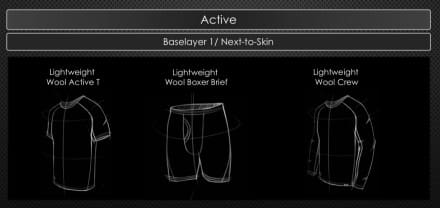
Base Layer 2 – Blended US Wool
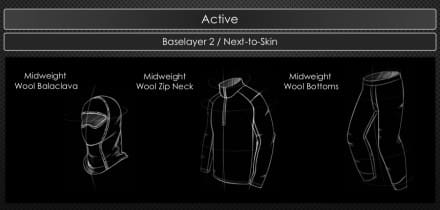
Cross Layer 1 – Woven Air Perm Materials
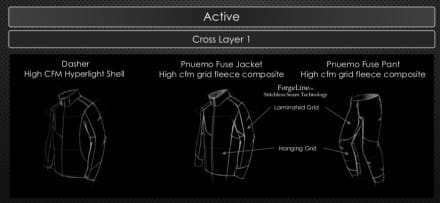
Cross Layer 2 – Woven Air Perm Materials
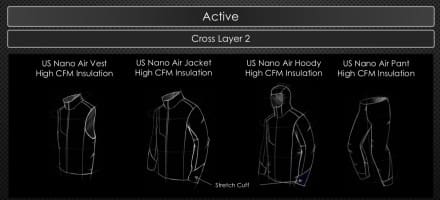
Outerwear 1 – Air Perm Softshell Laminate and Double Weave
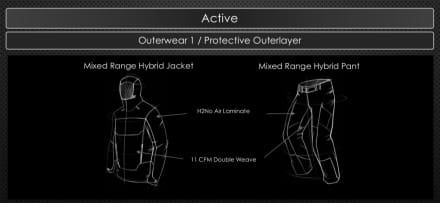
Outerwear 2 – Air Perm Wind Shell and Rain Suit
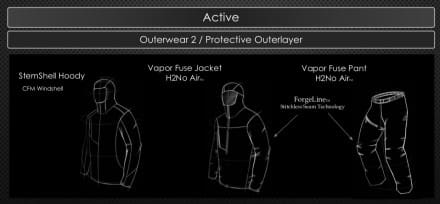
Outerwear Static – High Loft Insulation and Hardshell
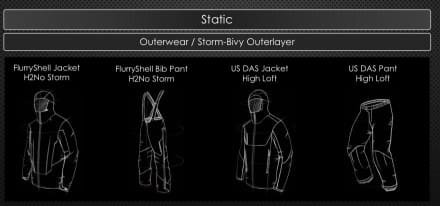
How It Works
PCU is a seven level system. It’s based on a mountaineering clothing system described by Mark Twight in his book “Extreme Alpinism: Climbing Light, Fast and High.” SOCOM has been using it for a little over 15 years. Even the US Army’s Extreme Cold Weather Clothing System Gen III is a simplified version of PCU. By this point, most users understand the concept of levels rather than layers and can combine different garments based on activity and environmental conditions.
Eric Neuron explained, “Layering works for surviving the elements, and it’s easy to teach and understand, but it’s not conducive for maximizing your working capability. MARS works just fine as a traditional layering system, but the vision was to create a toolbox of kit, that if you know your own bio-output and the task at hand, you only to need pull out the appropriate tools. The guys instinctively know this already, and the world’s top alpinist approach clothing this way, our task is simply to make the best tools.”
MARS is a completely fresh look at the challenge. Everyone will have to familiarize themselves with new garments and how to use them, alone, or in concert with one another. Then they’ll have to figure out which they’ll need to use in different scenarios. I’ve spoke with both Neuron and Shaw about this and they are looking at ways to help the user. One concept is an app which helps the user select the right pieces. Another, which was used with PCU, is offering instruction by SMEs.
Saving Time and Money
There’s a business case to be made for both client and vendor every time a new piece of equipment is purchased by the government. The cost of the system is the sum of all of the different elements from the supply chain as well as assembly of the materials into finished goods. As you’ll see, time is also a factor which must be considered. Some materials take longer than others to source.
Generally, an environmental clothing system relies upon multiple different materials which are combined to garner different effects. Each of those materials has its own part of the supply chain. The vendors who make those raw goods each have minimum order quantities (MOQ). Let’s say a system has five different materials. That’s five different MOQs which must be ordered. Each with their own lead times. Those all have to be synchronized so that they are ready for assembly at the same time. It gets even more complicated when clients want it in multiple paint jobs.
Some wonder why companies don’t want to have clothing systems, or other gear for that matter, sitting on the shelf. That’s because once those materials are assembled into a finished good, it costs money to carry on the shelf, hoping someone will buy it. Imagine a company builds a run of clothing and they manufacture a wide range of sizes. Some of those low demand sizes like extra long and extra short versions, may never be purchased. The capital wrapped up in finished goods isn’t recouped until they are sold and could be used elsewhere in a business such as paying for more raw goods to fulfill other orders.
One of the ways Patagonia has been able to lower their MOQs is by utilizing a common face fabric for most of these garments. That means the raw goods offer more versatility because they can be made into many different garments. Patagonia tweaks the fabric’s performance by applying treatments or laminating it to other materials, resulting in a highly efficient material usage across the system.
With MARS, Patagonia takes a stocking position for raw goods which cuts down on lead times for materials from mills and gives them the flexibility to produce what the customer wants. Granted, it’s not as fast as buying something off the shelf, but it also cuts out the wait for the supply chain to mill fabrics and treat them. Hopefully, it will be a happy medium. Of course, it relies on efficient customer forecasts.
“We believe that for a government contracting business, utilizing a build-to-order uniform business model that allows quick turns and low MOQ will ultimately provide the best value to the customer,” said Neuron, adding, “US manufacturing is expensive, we have worked hard to address that in the business strategy, and with an eye towards automation solutions to produce exceedingly technical domestic products. I believe this is the key to bolster the US clothing manufacturing base.”
One way to fulfill “we’re leaving tomorrow” requests is to work with distributors willing to take a stocking position on individual components of MARS or entire kits, based on their knowledge of their clients.
But going back to the idea of encouraging customers to buy what they need, minimums have dropped drastically. For instance, what once required a minimum order of 1000 kits has dropped to 200.
Additionally, MARS is completely Berry compliant. They selected materials which could be produced here in the US, yet still provide all of the performance they were looking for. They even went as far as designing a new buckle for the hood of the jacket.
These are technical garments using advanced materials and construction techniques. The most critical factor in the success of a revitalized MARS line is domestic production. Consequently, Patagonia has not only prepared a supply chain for the materials needed but also invested in their production partner, Peckham Vocational Industries. In doing so, they’ve installed machinery capable of modern construction techniques like sonic welding, as well as provided instruction on how to use them. Patagonia Subject Matter Experts have been on hand at Peckham, showing lead sewers tricks of the trade. This investment is going to allow the military to adopt more modern clothing designs and keeps Peckham competitive, even with overseas factories, which generally benefit from regular infusions of new machinery.
When I spoke with Eric Neuron about it, he said, “We are fortunate to be able to cut through the noise, and focus only on the goal of solving problems and bringing innovation to the guys. In this case, that means investment of time, money and knowledge transfer to the US supply chain. And we have the best US partners in place to deliver on that goal.”
Both Patagonia and Peckham have assumed some risk here. So far, they’ve got one customer, but by expanding the program they’ve taken the “build it and they will come” approach. There’s nothing like MARS currently in the market. While there are a lot of great individual pieces, from a variety of manufacturers, no one has taken such a bold move to introduce such an ambitious line all at once in quite some time. Even then, there were significant preorders. They’ll have to educate customers on the system, how to use it and how to purchase it.
This is the second of a four-part series on the Military Alpine Recce System developed by Patagonia’s The Lost Arrow Project. Other installments include an the history of Patagonia’s SOF support, a focus on their production partner Peckham Vocational Industries and a deep dive into some of the components. The full system will be on exhibit at SOF Select during SOFIC.
Most people who enjoy the outdoors know Patagonia as a company which produces outdoor clothing. Still others may know about Patagonia’s long-term dedication to social and environmental responsibility. While those may sound like marketing buzz-words, it turns out they manifest themselves in ways the average person would never imagine.
Social responsibility can mean a lot of things, to a lot of people. In Patagonia’s case, it’s a decision of where they dedicate resources.
What most do not know is that for more than a decade, Patagonia has focused their expertise at providing technical outerwear for the most extreme environments and athletes, to a different customer, US Special Operations Forces. That’s right. Patagonia has a dedicated team, focused on supporting USSOCOM with delivering US Made/Berry Compliant technical cold weather and combat uniforms as prime provider to the Protective Combat Uniform program. What’s more, they’ve cultivated a relationship with a like minded production partner, Peckham Vocational Industries. Itself a company founded upon service to others.
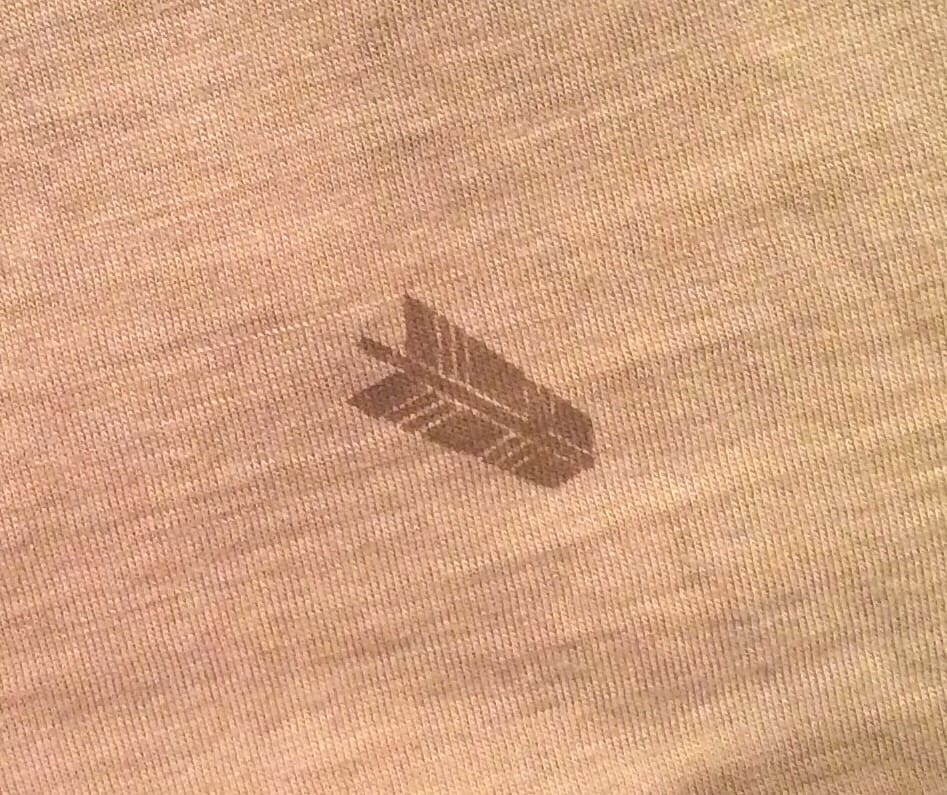
I spoke with Eric Neuron, Director of Strategic Product & Military for Patagonia Works and he related that one unintended, but important outcome of their military work has been a renewed focus on the US manufacturing base. They’ve spent the last three years investing in Peckham Vocational Industries, with technical machinery and knowledge transfer from their global supply chain. Their goal is to build the capacity to produce outdoor apparel that is technically equivalent to what they produce globally.
Part of their dedication to the environment is to produce durable goods which will last, despite arduous conditions, and won’t need to be replaced as often.
Even those familiar with Patagonia’s PCU work usually don’t know how long they have been supporting the military. My relationship with the brand goes back to the late 1980s, when I was assigned to 3rd ID’s Long Range Surveillance Detachment. We were issued thick dark blue pile suits to ward off the cold while in a hide site and polypropylene long underwear, complete with logo on the left chest. Not long after that, very close copies of those garments were included in the US Army’s Extended Cold Weather Clothing System. Right down to the nylon chest pocket.
Throughout the 90s, SOF units would issue specialized pieces of Patagonia clothing for use in extreme environments. But it was not until the Global War On Terror that Patagonia answered the nation’s call and began developing entire clothing systems for SOF.
In 2004, Patagonia commenced work for a SOF customer on an environmental clothing system which was comprised of modifications to what was already in their commercial line. Leveraging their Regulator line of inner layers, this project was dubbed the Military Advanced Regulator System or MARS. Some garments remained the same as their commercially available counterparts but with a color change to Alpha Green, while other items were slightly modified with additions such as sleeve pockets. Later, many components of MARS were produced in Coyote.
At around the same time, the Program Manager for SOF Survival, Support and Equipment Systems invited three vendors in to update their PCU ensemble. The first go around had been developed quickly in-house at Natick Soldier Systems Center, just outside of Boston, with the assistance of renown mountaineer Mark Twight.
The other two vendors bowed out after deciding that they didn’t want to lend their brand names to clothing produced in domestic factories they had little control over. Patagonia jumped in with both feet, refining PCU’s seven levels despite being limited to fabric technologies already in the program. They also worked tirelessly with the Ability One sew house which produced the gear, to keep quality high throughout the process. Even then, Patagonia’s role with PCU didn’t leverage their design capability.
Then, in 2009, Patagonia got their chance to take the lead on a clothing project for PM SSES who decided to develop a SOF Combat Uniform. This garment became PCU Level 9. They held a development event in El Paso, Texas, along with their Ability One partner, bringing in personnel from each of the SOF components to provide feedback on prototypes. This was very much a hands-on event, with multiple evaluations occurring as well as an early use of 3D laser scanning to determine sizes for the operators.
Patagonia’s Cyndi Davis was central in the development of that garment and someone SOCOM would continue to turn to for expertise in the ensuing years. The Patagonia team refined its initial concepts and turned the uniform into reality. Now, they also produce a jungle version of that uniform, called Level 9 HW.
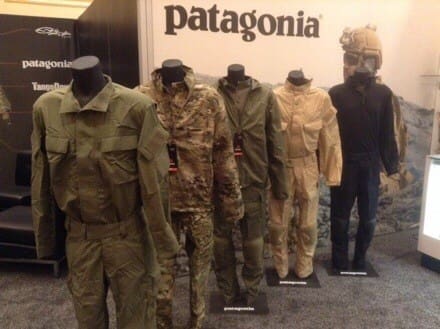
But they haven’t stopped there. Most recently, Patagonia formalized The Lost Arrow Project, a subsidiary of Patagonia Works that is solely focused on their government contracting business. Their aim is build special-purpose clothing and gear for extreme environments, developed specific to the requirements of the government user, and for compliancy in government contracting.
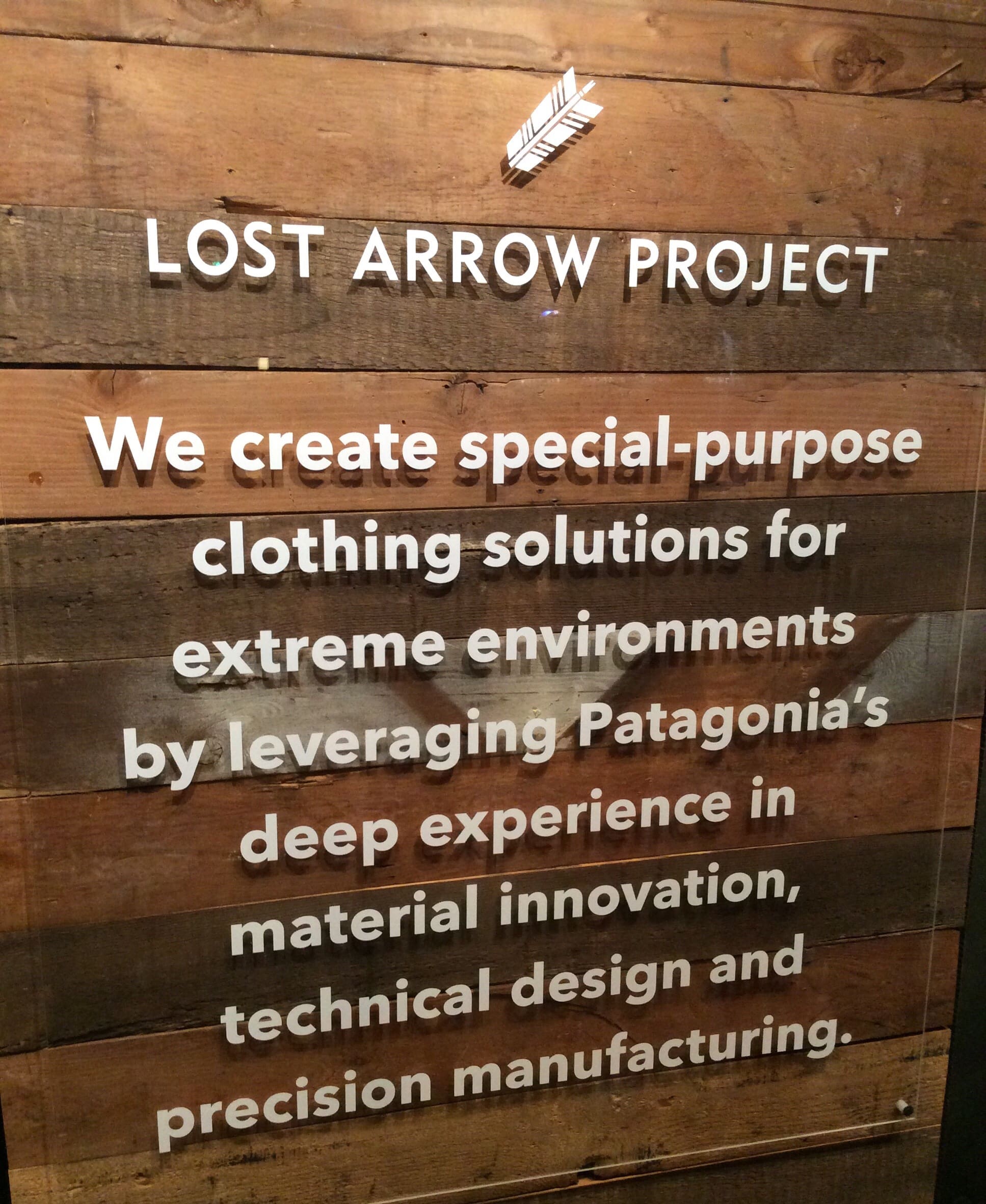
About three years ago, what was to become The Lost Arrow Project, decided to start with a clean slate, envisioning a follow-on to PCU. They brought in one of Patagonia’s most experienced designers, Casey Shaw, who began work on what would eventually become the Military Alpine Recce System. It’s still called MARS, but they’ve transitioned from their older Regulator technology to new materials with a focus on tailored breathability.
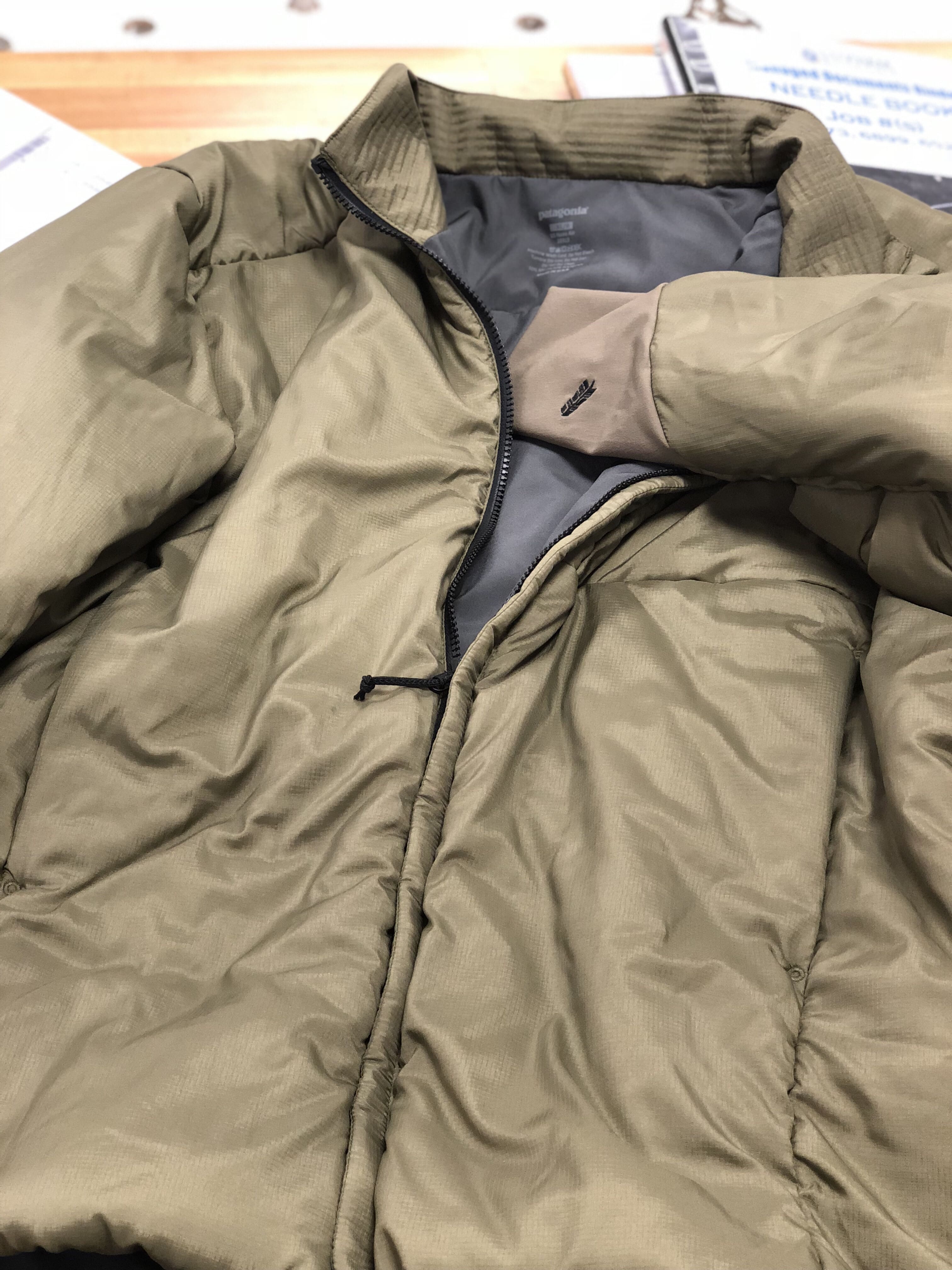
Eric Neuron, sums up their efforts quite well, saying, “The latest iteration of the MARS line of cold weather clothing has redefined the state of the art in domestic outerwear, is a paradigm shift from the status quo of cold weather layering systems, and is the culmination of The Lost Arrow Project.”
This is the first of a four-part series on the Military Alpine Recce System developed by Patagonia’s The Lost Arrow Project. Other installments include an overview of the system and its design, a focus on their production partner Peckham Industries and a deep dive into some of the components. The full system will be on exhibition at SOF Select during SOFIC.
US Elite Gear is now offering unbeatable prices on two popular items from Patagonia and Wild Things Tactical!
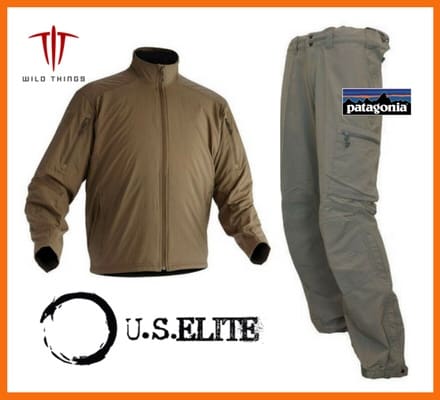
First up is the Low Loft Jacket S0 1.0 from Wild Things Tactical. This is a versatile, mid-layer jacket that is lightweight and highly compressible for packing. PrimaLoft® insulation keeps you warm even while wet and a water-resistant shell helps you stay dry in the first place. The jacket is available in Coyote and MultiCam®.
We’re also offering a classic military issued item from Patagonia, the Gen II Protective Combat Uniform (PCU) Level 5 pants. Originally developed for US Special Operation Command (SOCOM) following early experiences in Afghanistan, the PCU is the current system of cold weather garments. The Level 5 pants from Patagonia are a softshell trouser designed to replace your combat uniform when the temperature dips low. Side, waist and ankle zips give easy access to other layers and the waistband can accept belts and suspenders. The Gen II PCU Level 5 pants are available in the issued color of Alpha Green.
Check these classic items and more at US Elite. Check back often because you never know what might pop up!
While you can still find the original British Commando sweater, it’s always cool to find other options. In this case, it’s Patagonia’s Men’s Fog Cutter Sweater.
Made from 70% recycled wool/25% recycled nylon/5% other fiber blend; the shoulder patches have a DWR (durable water repellent) finish to shed moisture. However, unlike the British sweater, the Patagonia version does not have elbow patches.
Offered in Glades Green and Mohave Khaki, sizes Small – 3 XLarge. Patagonia lists it as a relaxed fit.
www.patagonia.com/product/mens-fog-cutter-work-sweater